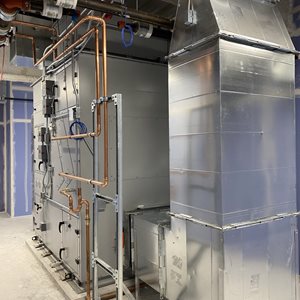A grain elevator does quite a lot for an industrial business in the feed industry.
It can not only lift a crop product like corn from the ground level to the top of bins, but it can also store corn, blend it and transfer it to trucks or railcars.
This mixing, dumping and movement naturally creates a lot of dust, so the machine also requires ventilation to keep the air clean and the employees working in the facility safe.
A larger scale project like this takes a lot of precision, which is why Central Sheet Metal, Columbus, Indiana, was called in to not only design the grain elevator’s ventilation using 3D modeling, but to also fabricate the pieces necessary and then install the final product, ensuring the machine worked seamlessly for a Franklin, Indiana feed business.
“This is our preference — to work with our clients from start to finish,” explained Vice President Nash Johnson. “The customer may not know ventilation as well as we do, so we can fully use our expertise to design the system for maximum efficiency, fabricate the pieces and even leave some pieces to cut during installation so they are remeasured, tweaked, and designed to fit perfectly during installation.”
FROM START TO FINISH
Central Sheet Metal has been providing custom metal and air ventilation solutions to customers for more than 50 years. Specializing in industrial work, the company can design, fabricate metal, install and maintain air ventilation systems.
The company attracts customers mostly via word-of-mouth — with customers in the Columbus, Indiana area, but it performs work all over the Midwest, as well as traveling to Nebraska and even Florida for industrial ventilation and custom fabrication. The company specializes mostly in industrial work, which makes up 80 percent of their business, with the other 15 percent going to commercial and 5 percent to residential work.
The company designs new systems as well as remodels and/or upgrades ventilation or dust collector systems as well. They employ staff with CAD/CAM software expertise, such as Auto CAD, Solid Works and Vicon, that help bring designs to reality, in addition to hand drawing skills.
Then, the company offers fabrication capabilities that include plasma table, press-brake forming, metal shearing, paint booth, welding, sheet metal rolling and punching.
Finally, Central Sheet Metal can install any ventilation systems and dust collectors to help exhaust harmful pollutants from the operation floor to outside of the building, keeping industrial facilities clean and meeting OSHA requirements.
UNDERSTANDING THE WORKINGS OF A GRAIN ELEVATOR
This is not the first grain elevator Central Sheet Metal has helped create, and in each situation the industrial feed clients come to the company with a need, but they allow Central Sheet Metal employees the freedom to use their expertise to design a system that works.
“In a perfect world, corn wouldn’t create dust, but it does — and not only is it a huge mess, but it can be harmful in large quantities,” Johnson explained. “Industrial ventilation works to remove this dust that’s created from the crop.
Dust from corn goes into a dust collector — “a glorified vacuum,” Johnson described — and goes through filters that catch the dust, removing it and cleaning the air.
Every six months to a year, Central Sheet Metal will clean the filters and inner workings of the machine, so it continues to work efficiently.
This job was considered a larger one for the company, taking approximately six weeks to complete from start to finish. As far as materials are concerns, the job took roughly 50 sheets of 5-foot by 10-foot pieces of sheet metal and quite a bit of spiral ductwork. Two men spent roughly 80 hours or two weeks of fabrication time on the project, with the rest happening in the field.
The challenge for this project was making sure a large industrial pipe that was 40 inches in diameter could make it through ceilings and cement flooring and not hit other plumbing or ductwork along the way. “When we go on site, a lot can change from what we thought after the initial measurements,” Johnson said. “We have to be adaptive and problem-solve from that point, which is something our skilled journeymen do very well.”
Central Sheet Metal experts also have to work with the large industrial fans, understanding the speeds at which certain types of dust will move in the air system to configure the proper duct size.
A difficult job like this requires a lot of calculations. “The client had to trust us to understand what they needed and that we’d figure out how to get it done,” Johnson said. “It’s important to have bright men and women in the field to do this work and help with sizing and envisioning the system we needed to build.”
The customer was pleased with how it turned out, and the job led to extra side work from this client — everything from additional fabrication to ventilation installation in other parts of their business, including exhausts for areas where the semi-trunks dump their corn.




_1.jpg?height=300&resizemode=force)